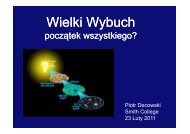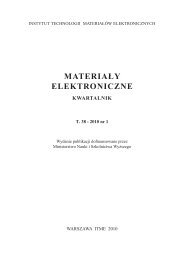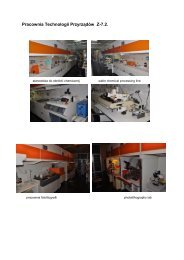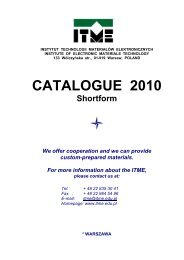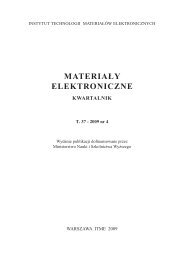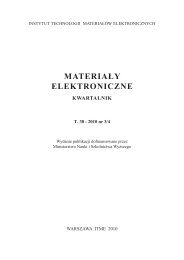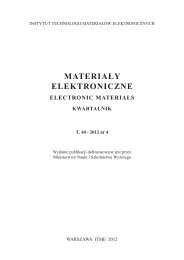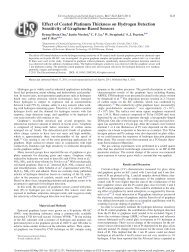Nr 1 - ITME
Nr 1 - ITME
Nr 1 - ITME
You also want an ePaper? Increase the reach of your titles
YUMPU automatically turns print PDFs into web optimized ePapers that Google loves.
Z. Szczepański, R. Kisiel<br />
As an example of adhesive bonding EPOTEK P-1011 has been chosen. This<br />
adhesive is characterized by high adhesion (shear strength 150 N/cm 2 ) and high<br />
temperature resistance. The SiC dies with two types of top metallization were used:<br />
Al and Au. For SiC die with Al top metallization adhesive die connections after long<br />
term ageing at 300ºC for 200 hours kept good mechanical strength. Unfortunately,<br />
during the ageing process (at 400ºC) SiC dies with Au top metallization, silver electromigration<br />
was observed after 100 hours of heating. Ag migrate from the bottom<br />
of die to the top SiC die surface with Au. So, applying adhesives with Ag for SiC<br />
with Au top metallization is not proper solution.<br />
The next assembly technology which was applied in our researches for SiC die<br />
connection is adhesive bonding with the use of inorganic composition, based on<br />
silver filled glass. Due to its high thermal conductivity (above 60 W/m K) and high<br />
operation temperature, this composition can fulfill demands for high temperature and<br />
high power applications. The composition was stencil printed on thick film gold on<br />
alumina substrate (stencil thickness 70 µm) and fired in belt furnace with 40 min.<br />
total firing cycle and 20 min firing at peak temperature of 500ºC. Some cracks on<br />
the edges of SiC structure was observed. Firing time was changing to reduce cracking<br />
at edges. By changing firing parameters no significant reduction of cracking<br />
was observed. After 24-48 hours of ageing above 300ºC, adhesion drastically decreased<br />
and SiC die fall down form the substrate. The degradation occurs between<br />
SiC surface and the inorganic composition. To improve the adhesion between SiC<br />
surface and inorganic composition the plasma oxidation of SiC surface was applied<br />
in the next series of experiments. Such prepared samples were characterized by<br />
good adhesion.<br />
Very easy joining method with the use of the thermally conductive adhesive<br />
transfer tape allows to realize die bonding at room temperature. As adhesive transfer<br />
tape ceramic filled acrylic with the thickness of 100 µm and 250 µm was applied.<br />
Such thermally conductive tape offers the combination of thermal conductivity,<br />
electrical insulation, sufficient adhesion and ease of assembly.<br />
The last assembly approach applied in our researches uses silver nanoparticles.<br />
In the researches silver powder with particles diameter of 20÷30 nm was used,<br />
together with organic additive which prevents the silver particles sintering at room<br />
temperature. Such silver composition was deposited on ceramic substrate pad metallization,<br />
consisted of thick film gold and silver evaporated layer. Next SiC die with<br />
Ti-Ag metallization was placed onto substrate bonding pads. Pressure sintering of<br />
silver nanoparticles at temperature above 250ºC was applied. During sintering heated<br />
work holder and heated electrode with external pressure (30 N/cm 2 ) was applied<br />
which enhances the sintering process, due increasing of the surface contacts between<br />
silver particles. Sintering process was carried out for 40 min. Bonds with good<br />
mechanical connection, and probably good high thermal conductivity was obtained.<br />
Silver layer increases adhesion between the die and substrate pads. The stability of<br />
103




